|
ANKLE SPRAINS
 Your
doctor will look at your ankle and ask about your
symptoms. You may also have x-rays to rule out a broken
bone. Treatment will depend on how bad your sprain is. For
a severe sprain, healing may take 3 months or more. Your
doctor will look at your ankle and ask about your
symptoms. You may also have x-rays to rule out a broken
bone. Treatment will depend on how bad your sprain is. For
a severe sprain, healing may take 3 months or more.
Symptoms
Your symptoms depend on how badly the ligaments are
damaged. You may have little pain and swelling if the
ligaments are only stretched. If the ligaments tear, you
will have more pain and swelling. The more severe the
sprain, the less you’ll be able to move the ankle or put
weight on it. The ankle may also turn black-and-blue and
the bruising may extend into the foot and leg.
BUNIONS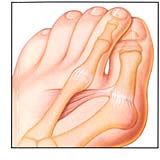
Your doctor can tell if you have a bunion from the look
and feel of your big toe. In some cases, you may have
x-rays to rule out arthritis. Although a bunion won't go
away, wearing shoes that fit properly will often relieve
the pain. Padding and icing the bunion may also help.
Orthotic control is always necessary to control and stop
the progression of the bunion. Bunions that remain painful
may need surgery.
Symptoms
A bunion often causes pain and swelling around the joint
at the base of the big toe. The skin may become red or
warm. If the big toe pushes under the second toe, a
painful corn may form on the top of the second toe. In
some cases, bunions cause no symptoms other than making
the foot harder to fit in a shoe.
HEEL PAIN
Wearing shoes with poor support and no cushioning can
irritate the tissue in the foot known as the plantar
fascia. Being overweight or standing for long periods of
time can also irritate this tissue. Any sport or activity
that puts stress on the foot can cause tears in the
plantar fascia and even fractures in the heel bone.

Symptoms
You may feel pain on the bottom or on the inside edge of
your heel. The pain may be sharp when you get out of bed
or when you stand up after sitting for a while. You may
feel a dull ache in your heel after you've been standing
for a long time on a hard surface. Running can also cause
a dull ache. If a nerve is irritated, you may feel burning
or a shooting pain in your heel.
METATARSALGIA
Metatarsalgia is often caused by wearing shoes with thin
soles and high heels. This puts extra pressure on the
bones in the ball of the foot. Standing or walking on a
hard surface for long periods also puts added pressure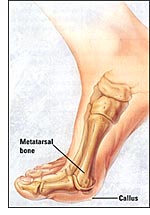 on the bones, causing pain. The pain can occur under any
of the five metatarsal bones. Bent or twisted toes and
bunions can make the problem worse. So can being
overweight. Sometimes high arches or arthritis can also
cause metatarsalgia.
on the bones, causing pain. The pain can occur under any
of the five metatarsal bones. Bent or twisted toes and
bunions can make the problem worse. So can being
overweight. Sometimes high arches or arthritis can also
cause metatarsalgia.
Symptoms
The most common symptom of metatarsalgia is pain in the
ball of the foot. it may feel as if you have a stone in
your shoe. The ball of the foot may also become red and
inflamed, and a callus may form under the end of the
metatarsal bone.
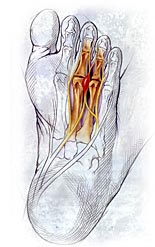 NEUROMA NEUROMA
Your doctor diagnoses a neuroma by checking your foot.
Treatment may include wearing wider shoes, soaking or
icing the foot, and putting a special pad in your shoe.
You may also be given medication. These steps most often
relieve the pain. If not, your doctor may suggest surgery
to cut the ligament or remove the nerve.
Symptoms
The most common symptom of a neuroma is pain in the ball
of the foot between two toes. The pain may be dull or
sharp. It may feel as if you have a stone in your shoe.
You may also have tingling or numbness in one or both of
the toes. Symptoms may occur after you have been walking
or standing for awhile. Taking off your shoes and rubbing
the ball of your foot may relieve the pain.
HAMMERTOES
Your doctor will examine your feet carefully. He or she
will check for corns and calluses and bend your toes to
see if the joints are still flexible. You may also have
x-rays to rule out arthritis. Buying shoes with more room
in the toes, filing down corns and calluses, and padding
the toe most often relieves the pain. If these steps don't
work, you may need surgery to straighten the toes.
Symptoms
You may feel pain in the toe or in the ball of your foot.
A corn (a hard growth of skin on the top of the toe) may
form where the toe rubs against the top of the shoe or a
callus (a hard growth of skin on the bottom of the foot)
may form under the tip of the toe or on the ball of the
foot. Corns and calluses can also be painful.
WARTS
A wart is an infection caused by a virus, which can invade
your skin through small cuts or breaks. Over time, the
wart develops into a hard, rough growth on the surface of
the skin. A wart is most commonly seen on the bottom of
the foot (plantar wart), but can also appear on the top.
Children, teens, and people with allergies or weakened
immune systems are more vulnerable to the wart virus.
Symptoms
Warts may appear spongy, with tiny red, brown, or black
spots. They can grow up to an inch or more across,
occurring alone (solitary) or with smaller warts clustered
nearby (mosaic). Warts are sometimes mistaken for corns or
calluses. They can persist for years and recur in the same
spot. If left untreated, warts can spread to other parts
of the foot or even to the hands or other areas of the
body.
BLACK-AND-BLUE NAILS
A black-and-blue nail is usually caused by sudden or
repetitive injury to a toe. This might occur during sports
that involve running or stopping quickly, such as tennis
or basketball. The injury may also result from a heavy
object falling on a toe.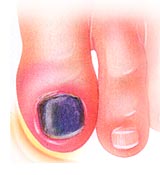
Symptoms
The big toe is most often affected. Bruised, broken blood
vessels cause the black-and-blue colors under the nail. If
the condition is the result of a sudden injury, pain may
be severe.
INGROWN
NAILS
An ingrown nail is the result of a nail growing into the
skin that surrounds it. This often occurs at either edge
of the big toe. Ingrown nails may be caused by improper
trimming, inherited nail deformities, injuries, fungal
infections, or pressure.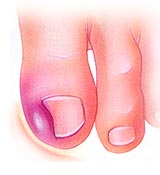
Symptoms
Ingrown nails may cause pain at the tip of the toe or all
the way to the base of the toe.
The pain is often worse while walking. An ingrown nail may
also lead to infection or inflammation. If it's infected,
you might see pus or redness.
THICKENED NAILS
Abnormally thick or crumbling nails may be caused by
injuries, pressure from shoes, fungal infections, or
conditions such as diabetes, psoriasis, or vascular
disease. Eventually, the nail may loosen and fall off.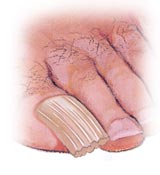
Symptoms
Along with thickening, the nail may appear ridged,
brittle, or yellowish. The nail may also feel painful when
pressure is put on it.
|